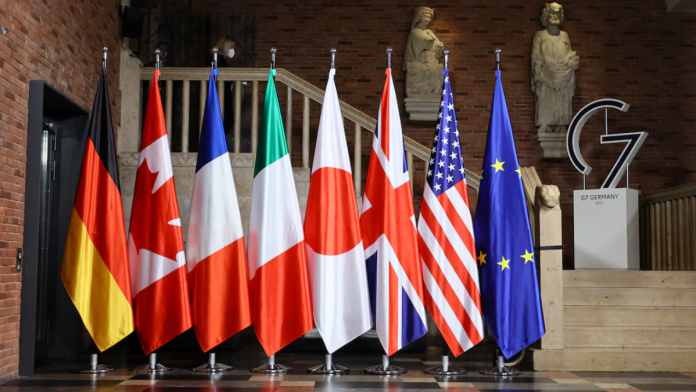The world’s most powerful economies are moving towards a new plan to hurt Russia’s ability to fund its war. According to a draft statement, the Group of Seven (G-7) nations are preparing to increase sanctions on Russia. These measures are aimed at targeting its energy income, financial systems, and military industry. The draft shows that leaders believe this is the right moment to act together and apply stronger pressure.
The G-7 is made up of the United States, the United Kingdom, France, Germany, Italy, Japan, and Canada. They are now working to finalize the details. Finance ministers from these countries are set to discuss the draft further. The text is not yet final, but sources say a joint announcement is expected soon.
Rising Russian Military Output Despite Sanctions
Even with current restrictions, Russia has increased its military production in recent years. Numbers from the Kiel Institute for the World Economy show sharp rises across multiple categories.
In the last quarter of 2022, Russia produced 123 tanks. By the first quarter of 2025, this number had jumped to 444, a rise of 260 percent. Fighting and mobility vehicles went from 585 to 1,641 in the same period, an increase of 180 percent. Artillery production grew by 180 percent, while short-range air defense systems rose 233 percent.
Drones, known as Lancet loitering munitions, also grew sharply. From 93 in late 2022, the figure reached 336 in early 2025, showing an increase of 261 percent. These numbers suggest that Moscow has managed to step up its weapons output even under pressure.
This growth in arms production is one of the main reasons the G-7 nations are pushing for tougher sanctions. They believe new measures must cut deeper into Russia’s oil exports, which remain a key source of money for its military campaigns.
Targeting Oil Exports, Tankers, and Hidden Networks
The draft statement under discussion highlights the need to maximize pressure on Russia’s oil sales. Oil is one of Moscow’s main revenue streams. The G-7 is considering several moves that would directly hit this sector. These include placing sanctions on major Russian oil companies and restricting its shadow fleet of tankers. This fleet is used to move oil through alternative routes in an attempt to avoid restrictions already in place.
Beyond oil, the draft mentions targeting financial networks and military industry firms that continue to fuel the war effort. It also points to actions against countries and entities that help Russia bypass existing sanctions. By tightening the net around these support systems, the G-7 hopes to limit Moscow’s ability to sustain its wartime economy.
Austria’s Raiffeisen unable to complete sale of its Russian operations
There is also discussion about the frozen assets of Russia’s central bank. The draft notes that finance ministers will explore coordinated ways of making further use of these blocked funds. Large amounts of Russian state money have been held abroad since the war began, and governments are looking into how these could help meet Ukraine’s financial needs.
EU Leaders Push Parallel Measures
At the same time, the European Union is preparing its own sanctions package. Leaders are gathering to discuss a plan that could channel €140 billion, or about $164 billion, in aid to Ukraine by using Russian assets immobilized in the bloc. The EU is also working on further restrictions that could see a ban on Russian liquefied natural gas imports by 2027.
New measures under consideration would hit both the energy and financial sectors. By aligning their steps, the EU and the G-7 are attempting to present a united front. Both groups are aiming to finalize their decisions within this month, according to officials familiar with the talks.
This alignment shows growing momentum among Western allies to tighten economic pressure on Moscow, particularly through its vital oil revenues. These coordinated efforts mark one of the most significant moves yet to curb Russia’s ability to finance its ongoing war.


